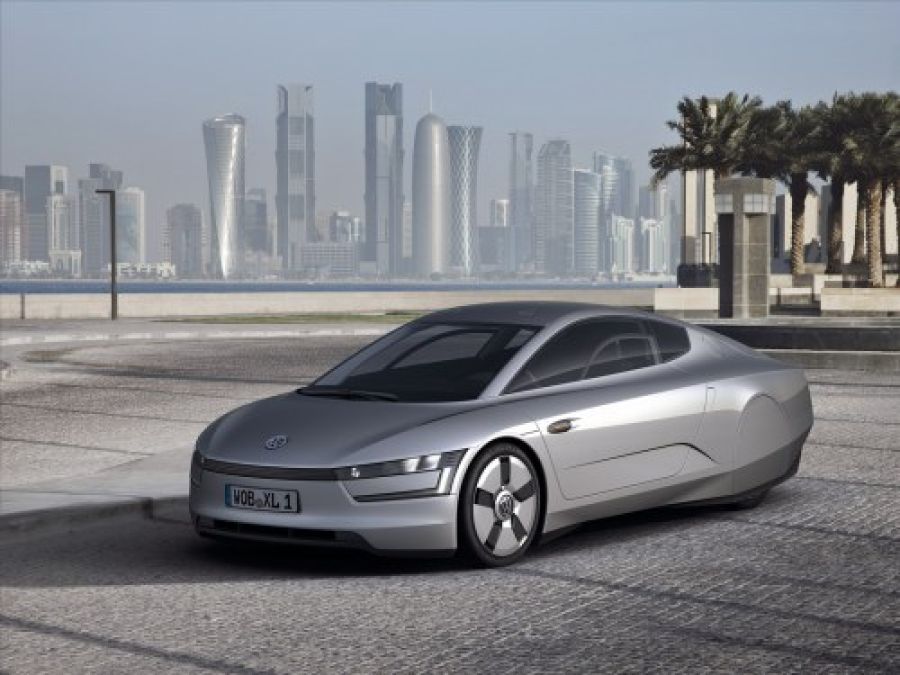The XL1 is described by Automotive News as a plug-in diesel hybrid concept, claiming 261 mpg. DieselStation.com photos show its forward and visionary style.
That alone makes it like no other hybrid car powered by an electric motor / internal combustion engine combination; and equates to a fuel consumption of merely 0.91 per 100 km.
According to the Volkswagen news release, the key question is: Just how much could the energy consumption of cars be reduced if all the stops were pulled out for efficiency? Now we have an answer.
Conceptually, the XL1 represents the third evolutionary stage of Volkswagen’s 1-liter car strategy. When the new millennium was ushered in, Prof. Dr. Ferdinand Piëch, who is today Chairman of the Supervisory Board of Volkswagen AG, formulated the visionary goal of bringing to the market a production car that was practical for everyday use with a fuel consumption of 1.0 liter per 100 km.
In the new XL1, Volkswagen is demonstrating that this goal is now within reach.
The new Volkswagen XL1 attains a CO2 emissions value of 24 g/km, thanks to a combination of lightweight construction (monocoque and add-on parts made of carbon fibre), very low aerodynamic drag (Cd 0.186) and a plug-in hybrid system - consisting of a two cylinder TDI engine (35 kW / 48 PS), E-motor (20 kW / 27 PS), 7-speed dual-clutch transmission (DSG) and lithium-ion battery.
With a fuel consumption of just 0.9 l/100 km, the new Volkswagen XL1 only emits 24 g/km CO2.
Since it is designed as a plug-in hybrid, the XL1 prototype can also be driven for up to 35 kilometers in pure-electric mode; meaning, zero emissions at point of use. The battery can be charged from a conventional household electric outlet.
Like the Chevy Volt and similar systems, battery regeneration is also employed to recover energy while slowing down and store as much of it as possible in the battery for re-use. In this case, the electric motor acts as an electric generator.
In the new XL1, wing doors make it easier to enter and exit the car. Developers were able to design a body layout that offers greater everyday practicality, incorporating side by side seating rather than the tandem arrangement seen in both the first 1-liter car presented in 2002 and the L1 presented in 2009.
Further progress has been made by manufacturing body parts from carbon fiber reinforced polymer parts (CFRP), a technique used in Formula 1 car construction. Volkswagen has even developed and patented a new system for CFRP production in what is known as the aRTM process (advanced Resin Transfer Molding).
The two cylinder, 0.8 liter TDI (35 kW / 48 PS) was derived from the 1.6 liter TDI, which drives such cars as the Golf and Passat. With the goal of reducing emissions, exhaust gas recirculation and an oxidation catalytic converter as well as a diesel particulate filter are used. Equipped in this way, the 0.8 TDI already fulfils the limits of the Euro-6 emissions standard.
-----------------------
About the Author: After 39 years in the auto industry as a design engineer, Frank Sherosky now writes articles, books and ebooks via authorfrank.com, but may be contacted here by email: [email protected]
_________________________________________________________________
Additional Reading:
High-efficiency small cars shine at 2011 Detroit Auto Show
Toyota expanding marketability of Prius at 2011 Detroit Auto Show
Honda Civic GX the only natural-gas passenger car at 2011 Detroit Auto Show





